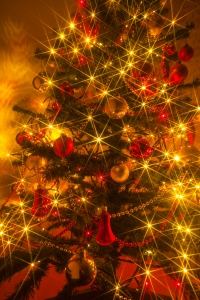Which is greener - real or artificial Christmas trees? The debate goes on...

courtesy sxc.hu
It used to be pretty clear-cut: real evergreens were never green! Thinking we were being eco-friendly, we bought faux firs to avoid chopping down real trees. But the evidence seems to say chop away!
A few fir facts:
• Some 33 million real Christmas trees are sold in North America each year, according to the U.S. EPA. About 93 percent of those trees are ground into mulch through recycling programs.
• Christmas tree farms grow trees for that purpose, so we're not depleting forests when we buy Christmas trees. Also these farms plant two or three seedlings for every tree sold.• Fake trees are made with metal and polyvinyl chloride (PVC), a non-biodegradable and petroleum-derived plastic that produces carcinogens during manufacture and disposal. Many older trees may even contain lead, which was once used as a stabilizer during manufacture.
• About 85 percent of artificial trees sold here are imported from China, which adds significantly to their environmental footprint.
So, it seems clear that if you have no tree and want to buy one, a freshly cut tree is the greener option. However, if you already own a fake tree, continuing to use that tree makes green sense. You’re postponing its destiny in the landfill and saving gas you would have used to buy a real tree.
Are you for real? Or faux? Leave a comment!
I know what you’re thinking… why do we have to choose between real and fake Christmas trees, anyway?
We don’t! We can avoid that entire debate:
• Get a potted tree, such as a Norfolk Island pine. I got one each year when I lived in an apartment and real cut trees weren’t allowed. They don’t smell like a Christmas tree, and you can’t load them up with lights and heavy ornaments, but they are real and they’re evergreens. I could never get them to survive much beyond the holidays, though…
• Get a real uncut evergreen tree and plant it outside after Christmas. For some how-to tips, click here.
Or… you could create the “sense of a tree” in your home. Check out my next blog for some ideas on thinking outside the boxwood.
Judy DiForte is a professional organizer with The Betty Brigade, a relocation, organizing and event planning company based in Ann Arbor. She welcomes your comments. Also you can email her at judy@bettybrigade.com. Check out our newsletter archive here.


Comments
Andrew R. Gorsuch
Mon, Dec 12, 2011 : 2:06 p.m.
I say buy a Michigan Grown Christmas Tree! Michigan ranks third in the country in the number of Christmas trees harvested, and no other state produces more Christmas tree varieties. Michigan's 700 Christmas tree growers harvest about 3 million trees a year, according to information from the state.
Judy DiForte
Mon, Dec 12, 2011 : 8:35 p.m.
Buying a tree from a local farm also saves gas.
Wolf's Bane
Mon, Dec 12, 2011 : 1:37 p.m.
Artificial trees are all about convinence and not the holiday spirit.
Wolf's Bane
Mon, Dec 12, 2011 : 1:36 p.m.
PVC is a petroleum based product and trees, while certainly chopped down for use as Christmas Trees, spend their lifetime soaking up carbon monoxide. So, the choice is pretty clear, huh? Not be disrespectful, but let's try a poll that is bit more interesting?
Judy DiForte
Fri, Dec 9, 2011 : 5:08 p.m.
I just received this email from Jami Warner, exec. director of the American Christmas Tree Assn, and she gave me permission to post it here as a comment: I just read your column about Christmas trees and I thought you would be interested in the results of a just-released Life Cycle Analysis conducted by PE International comparing the environmental impact of the most common real tree to the most common artificial tree. The study concluded that either tree has a negligible impact on the environment. The full study can be accessed at <a href="http://www.christmastreeassociation.org" rel='nofollow'>www.christmastreeassociation.org</a>. I realize that it my seem more compelling to pit the Christmas tree growers against the artificial Christmas tree retailers but from our association's standpoint, there is no debate. The Christmas tree industry in the U.S., real and artificial, employs thousands of Americans. We truly embrace consumer choice and believe there is the right Christmas tree, be it real or artificial, for everyone who chooses to celebrate Christmas with a Christmas tree. Thank you very much and Happy Holiday's. Best regards, Jami Warner Executive Director American Christmas Tree Association
Sarah Rigg
Fri, Dec 9, 2011 : 3 p.m.
We also buy a small live tree and transplant to the yard when Christmas is over. We've had mixed luck - 3 out of about 8 trees have survived.
Sarah Rigg
Thu, Dec 15, 2011 : 5:23 p.m.
Judy: Yes, I think that was part of it. Gradual move from outside to in and then inside to out is helpful too. Think: outside to garage or screened porch to inside over the course of a couple days, and then the opposite at the end of the season.
Judy DiForte
Sat, Dec 10, 2011 : 2:53 p.m.
Did you do anything differently with the ones that survived? Maybe kept it inside for fewer days?
Ricebrnr
Fri, Dec 9, 2011 : 12:43 p.m.
So what is the carbon footprint of my fake tree amortized over 15 plus years and counting?
Judy DiForte
Sat, Dec 10, 2011 : 2:51 p.m.
Here is the actual study Jamie refers to below: <a href="http://www.christmastreeassociation.org/pdf/ACTA%20Christmas%20Tree%20LCA%20Final%20Report%20November%202010.pdf" rel='nofollow'>http://www.christmastreeassociation.org/pdf/ACTA%20Christmas%20Tree%20LCA%20Final%20Report%20November%202010.pdf</a> see pp 82 and 83, especially. Looks like you are definitely in the green!